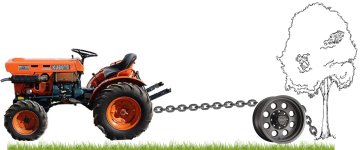My location has a number of interesting terrain problems. One of these is a normally well maintained earthen dam which has had recurring alders coming back each year below the mowing line, and refusing to give up no matter how many times pruned to ground level. The last couple of years pruning was not done resulting in 3"-4" trunk size trees.
Also my front yard has a few very steep and very tractor unfriendly areas where some small "trash" trees need to be removed before they become larger trees (or if simply cut, sprouting a whole bunch more suckers, etc).
Since I am not about to risk my tractor (not to mention my backside) in either of these steep areas, it was worthwhile to cobble up this frame which is designed to stand up near the base of the small tree, wrap and hook a choker chain around the base of the tree, hook the chain into the slotted top of the frame, and continue on to the tractor's drawbar (located safely on top of the dam).
I had previously tried just a straight pull without the frame, resulting in little more than laying the tree over and digging some nasty wheel wells in the top of the dam.
With the frame, the tractor didn't even slow down

Sherweld
